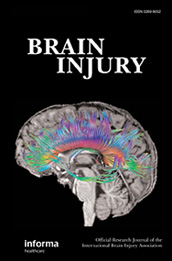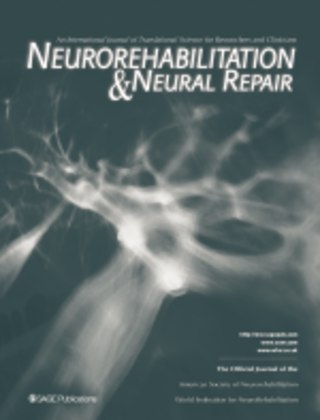
Neurology is the branch of medicine dealing with the diagnosis and treatment of all categories of conditions and disease involving the nervous system, which comprises the brain, the spinal cord and the peripheral nerves. Neurological practice relies heavily on the field of neuroscience, the scientific study of the nervous system.
A communication disorder is any disorder that affects an individual's ability to comprehend, detect, or apply language and speech to engage in dialogue effectively with others. This also encompasses deficiencies in verbal and non-verbal communication styles. The delays and disorders can range from simple sound substitution to the inability to understand or use one's native language. This article covers subjects such as diagnosis, the DSM-IV, the DSM-V, and examples like sensory impairments, aphasia, learning disabilities, and speech disorders.

Apraxia is a motor disorder caused by damage to the brain, which causes difficulty with motor planning to perform tasks or movements. The nature of the damage determines the disorder's severity, and the absence of sensory loss or paralysis helps to explain the level of difficulty. Children may be born with apraxia; its cause is unknown, and symptoms are usually noticed in the early stages of development. Apraxia occurring later in life, known as acquired apraxia, is typically caused by traumatic brain injury, stroke, dementia, Alzheimer's disease, brain tumor, or other neurodegenerative disorders. The multiple types of apraxia are categorized by the specific ability and/or body part affected.

Locked-in syndrome (LIS), also known as pseudocoma, is a condition in which a patient is aware but cannot move or communicate verbally due to complete paralysis of nearly all voluntary muscles in the body except for vertical eye movements and blinking. The individual is conscious and sufficiently intact cognitively to be able to communicate with eye movements. Electroencephalography results are normal in locked-in syndrome. Total locked-in syndrome, or completely locked-in state (CLIS), is a version of locked-in syndrome wherein the eyes are paralyzed as well. Fred Plum and Jerome B. Posner coined the term for this disorder in 1966.
Neurodevelopmental disorders are a group of conditions that begin to emerge during childhood. According to the American Psychiatric Association Diagnostic and Statistical Manual of Mental Disorders, Fifth Edition, (DSM-5) published in 2013, these conditions generally appear in early childhood, usually before children start school, and can persist into adulthood. The key characteristic of all these disorders is that they negatively impact a person's functioning in one or more domains of life depending on the disorder and deficits it has caused. All of these disorders and their levels of impairment exist on a spectrum, and affected individuals can experience varying degrees of symptoms and deficits, despite having the same diagnosis.
Language disorders or language impairments are disorders that involve the processing of linguistic information. Problems that may be experienced can involve grammar, semantics (meaning), or other aspects of language. These problems may be receptive, expressive, or a combination of both. Examples include specific language impairment, better defined as developmental language disorder, or DLD, and aphasia, among others. Language disorders can affect both spoken and written language, and can also affect sign language; typically, all forms of language will be impaired.

Developmental coordination disorder (DCD), also known as developmental motor coordination disorder, developmental dyspraxia or simply dyspraxia, is a neurodevelopmental disorder characterized by impaired coordination of physical movements as a result of brain messages not being accurately transmitted to the body. Deficits in fine or gross motor skills movements interfere with activities of daily living. It is often described as disorder in skill acquisition, where the learning and execution of coordinated motor skills is substantially below that expected given the individual's chronological age. Difficulties may present as clumsiness, slowness and inaccuracy of performance of motor skills. It is often accompanied by difficulty with organisation and/or problems with attention, working memory and time management.
Theresa A. Jones is a researcher and professor at the University of Texas at Austin and the Institute for Neuroscience. Her interests are in neural plasticity across the lifespan, motor skill learning, mechanisms of brain and behavioral adaptation to brain damage, and glial-neuronal interactions. Her research is on the brain changes following stroke, in particular rehabilitation strategies and the brain changes associated with them. She primarily tests rats and uses the Endothelin-1 stroke model. Her most recent work has expanded into the field of microstimulation mapping of the rat cortex.
Neurorehabilitation is a complex medical process which aims to aid recovery from a nervous system injury, and to minimize and/or compensate for any functional alterations resulting from it.

A neurological disorder is any disorder of the nervous system. Structural, biochemical or electrical abnormalities in the brain, spinal cord or other nerves can result in a range of symptoms. Examples of symptoms include paralysis, muscle weakness, poor coordination, loss of sensation, seizures, confusion, pain, tauopathies, and altered levels of consciousness. There are many recognized neurological disorders, some relatively common, but many rare. They may be assessed by neurological examination, and studied and treated within the specialties of neurology and clinical neuropsychology.

The Journal of Autism and Developmental Disorders is a monthly peer-reviewed medical journal covering research on all aspects of autism spectrum disorders and related developmental disabilities. The journal was established in 1971 as the Journal of Autism and Childhood Schizophrenia, obtaining its current title in 1979. It is published by Springer Science+Business Media and the editor-in-chief is Lynn Kern Koegel.

Brain Injury is a monthly, peer-reviewed, medical journal published by Taylor & Francis. Furthermore, it is the official journal of the International Brain Injury Association (IBIA). The chief editors are Jeffrey Kreutzer and Nathan Zasler.

The Kennedy Krieger Institute is a nonprofit, 501(c)(3) tax-exempt, Johns Hopkins affiliate located in Baltimore, Maryland, that provides in-patient and out-patient medical care, community services, and school-based programs for children and adolescents with learning disabilities, as well as disorders of the brain, spinal cord, and musculoskeletal system. The Institute provides services for children with developmental concerns mild to severe and is involved in research of various disorders, including new interventions and earlier diagnosis.

The Neuroscientist is a peer-reviewed academic journal that publishes papers in the field of Neurology and Neuroscience. The journal's editor is Stephen G Waxman. It has been in publication since 1995 and is currently published by SAGE Publications.

Neurorehabilitation and Neural Repair is a peer-reviewed medical journal that publishes papers in the fields of rehabilitation and clinical neurology. The editor-in-chief is Randolph J. Nudo, PhD. It was established in 1987 and is currently published by SAGE Publications in association with American Society of Neurorehabilitation.

The Journal of Neurotrauma is a monthly peer-reviewed medical journal covering research on neurotraumas. It is an official journal of the National Neurotrauma Society and the International Neurotrauma Society. The journal was established in 1984 and is published by Mary Ann Liebert, Inc. The editor-in-chief is David L. Brody, MD, PhD.
Vicki Anderson is an Australian clinical neuropsychologist and researcher. Since 2002 she has been the Theme Director of the Critical Care and Neurosciences group at the Murdoch Children's Research Institute in Melbourne, Australia, and she established the Australian Centre for Child Neuropsychological Studies at the Royal Children's Hospital.

Rajiv Ratan is an Indian American academic, professor, administrator and scientist based in New York. He is the Burke Professor of Neurology and Neuroscience at Weill Cornell Medicine. Since 2003, he has served as the executive director of Burke Neurological Institute and as a member of the Council of Affiliated Deans of Weill Cornell Medicine.
Alan J. Thompson, MD, FMedSci, FRCP, FRCPI, is Dean of the Faculty of Brain Sciences at UCL; Pro-Provost for London at UCL; Garfield Weston Professor of Clinical Neurology and Neurorehabilitation at the UCL Queen Square Institute of Neurology. He is also a consultant neurologist at the University College London NHS Hospitals Foundation Trust working at the National Hospital for Neurology and Neurosurgery. He is Editor-in-Chief for Multiple Sclerosis Journal.

Diane Louise Damiano is an American biomedical scientist and physical therapist specializing in physical medicine and rehabilitation approaches in children with cerebral palsy. She is chief of the functional and applied biomechanics section at the National Institutes of Health Clinical Center. Damiano has served as president of the Clinical Gait and Movement Analysis Society and the American Academy for Cerebral Palsy and Developmental Medicine.













